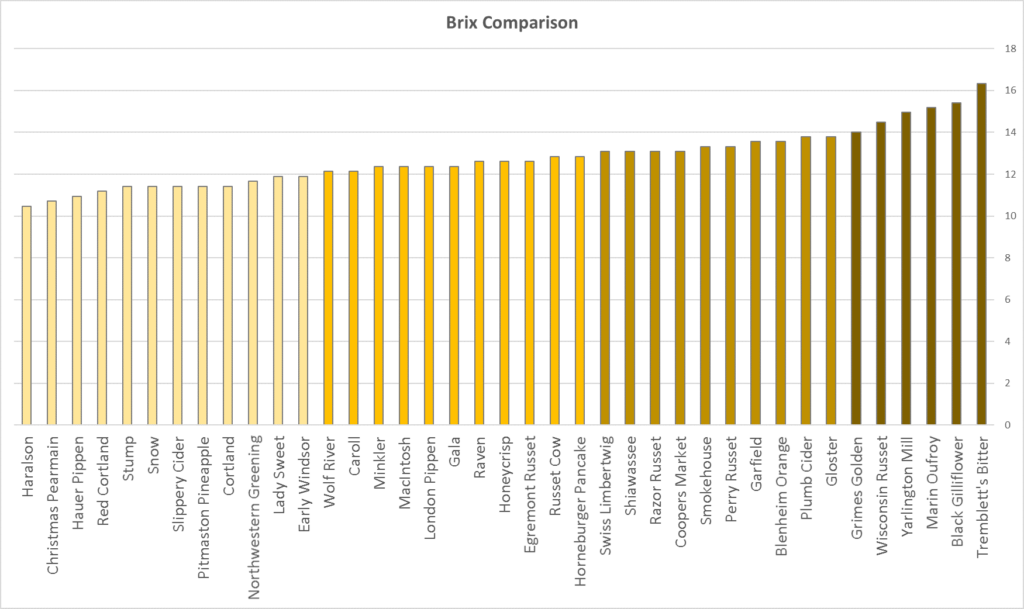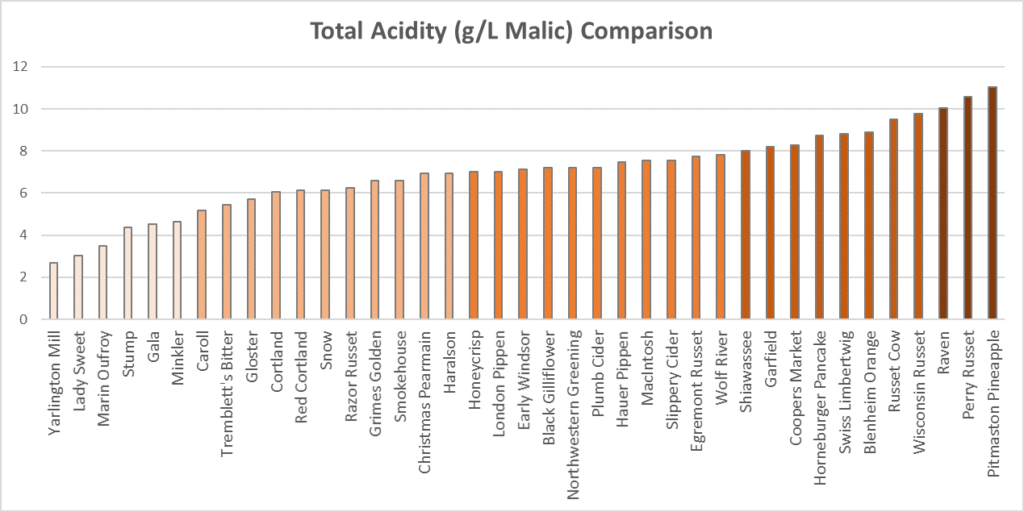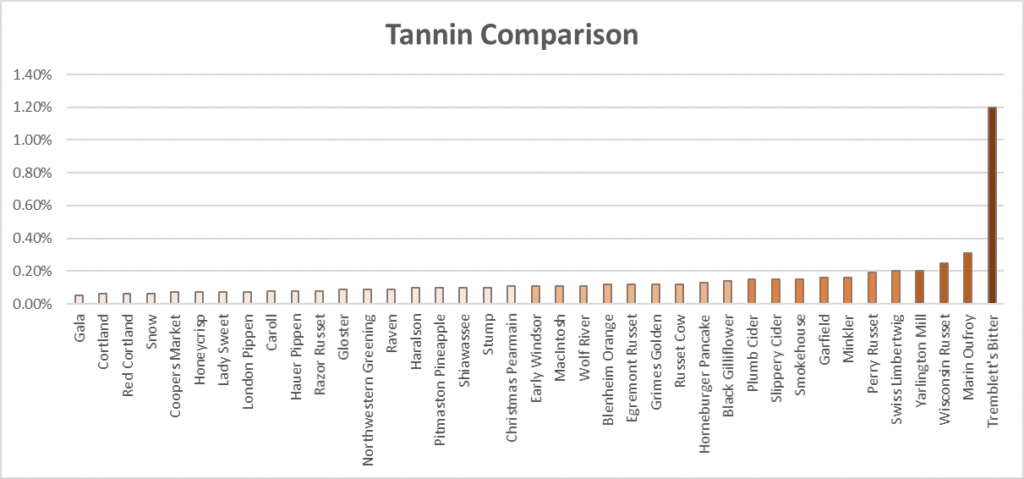2016 Annual Report for FNC16-1053
Apples for Artisanal Cider: Understanding the Characteristics of Single Varietals
Summary
Progress Report Year: 2016-2017
Website: brixcider.com
WORK ACTIVITIES
In the fall of 2016, we purchased the majority of project supplies and materials, including fermentation vessels, airlocks, yeast, sanitizer, campden tablets, and other supplies needed for fermenting the ciders. We also purchased all supplies for testing the ciders, including a refractometer, a pH meter, and chemical reagents. Most importantly, we purchased the apples. The original plan for the project was to source the apples from Seed Savers Exchange orchard, but due to a late frost and some heavy storms, they did not have a harvestable crop this year. As an alternative, we sourced the majority of the apples from Albion Prairie Farm which has a large collection of cider apples. We also purchased additional apple varieties from Appleberry Farm. The resulting apples represented a mix of English and French cider apples, American heirloom cider apples, American heirloom multi-purpose apples, unique local apples, and some common eating apples.
We pressed and fermented all of the apples using the same methods (same yeast, same temperature, same yeast nutrients, etc.) so that any differences in the resulting ciders would be due to the different apples as opposed to differences in the fermentation process. We tested each juice and recorded brix, specific gravity, total acidity, and total tannins. Each of the ciders went through a 3-week primary fermentation followed by a 6-week secondary fermentation. All of the ciders were then bottled and pasteurized.
We then tasted the finished ciders and evaluated them, recording notes on color, aroma, multiple flavor components, and our overall impression. At the time of writing we have tasted and evaluated 30 of the finished ciders.
We have posted all results this far on our company website: brixcider.com. The posted results include a photo of each apple, a photo of each cider, results from the juice analysis of each cider, and results of our qualitative tasting of each cider. Matt also presented at the Illinois Specialty Growers Conference as part of the SARE Farmers Forum, sharing results of the project to date.
RESULTS TO DATE
The brix of each cider ranged from 10.5 on the low end to 16.3 on the high end. Generally a high brix level is desired to make a good cider, and anything under 10 would not be desirable. Most of our favorite ciders were those on the higher end of the brix scale, and some of the ciders we found least desirable were on the lower end of the scale. Figure 1 shows the brix measurement for all of the apples.
Figure 1:

For acidity, most cider makers desire a moderate level (around 6 g/L of Malic acid equivalent), and different apples are typically blended to attain a desired level of acidity. Ciders that we tested ranged from a very low 2.7 g/L total acidity to a very high 11.0 g/L. They therefore offer a range of different blending possibilities. Figure 2 shows the acidity measurements for all of the apples.
Figure 2:

Tannins are highly desired by cider makers, and are typically in low supply in common eating apples. Tannins supply bitterness and astringency that adds flavor complexity and fills out a cider. An apple is considered high in tannins if tannin levels measure at 0.20% or higher. Among the apples we tested, only 4 were high in tannins according to this measure. Several other apples fell between 0.15% and 0.20% and were therefore on the cusp of being high in tannins. In general, we enjoyed the higher tannin apples more than those that were lower in tannins, suggesting that cider makers are correct in pursuing higher tannin apples. For future, similar studies, we believe it would be advantageous to focus on higher tannin apples that growers are currently experimenting with.
Figure 3:

In the qualitative evaluation of each of the ciders, none of the ciders thus far have been “bad.” There have been a few apples that were clear standouts compared with others and made very enjoyable ciders. Some of our favorites thus far have included Yarlington Mill, Marin Oufroy, Wisconsin Russet, Black Gilliflower, Plumb Cider, and Minkler. This gives us some confidence that these may be apples that we would like to grow more of in the future.
WORK PLAN FOR 2017
Our first task in the coming year will be to finish tasting and evaluating each of the ciders. We are then planning to host a cider tasting with other apple growers, cider makers, and with Nick Smith, the University of Wisconsin Wine and Cider Outreach Specialist. This tasting will be used to validate and/or edit the findings from our own tasting of the ciders. We will also add their comments to our descriptions of each of the resulting ciders.
Matt is also scheduled to speak about this project at the United States Association of Cider Makers annual conference (called CiderCon) in Chicago in February. At the end of this presentation, we will also conduct a tasting session of the ciders so that cider makers from around the country will have the opportunity to try the single varietal ciders for themselves. Comment cards will be given out so that these cider makers can also add their expert opinions to the evaluation of each of the ciders.
In the coming summer, we are also planning to host a field day where we will discuss the results of the study and allow participants to try many of the ciders. We plan to invite other local apple growers and cider makers as well as research, outreach, and extension professionals.
OUTREACH
We are actively posting all results on our website: brixcider.com. This includes a database of apples where visitors to the website can easily click on any of the apples we tested for more information. After clicking on a chosen apple, viewers will be brought to a separate page for each apple which includes a photo of the apple, a photo of the resulting cider, an apple description, results of our juice analysis, and a description of the resulting cider, including color, aroma, flavor, and overall impression. When the complete results are all posted, we plan to share the webpage broadly through social media.
Matt also presented at the NCR-SARE Farmers Forum held at the Illinois Specialty Crop, Agroforestry and Organic Conference in January 2017. The audience was small (14 people) but the presentation was video recorded so that it can be shared more broadly.
For the Cider Conference in Chicago, we are expecting an audience of 120 people (approximately 10 percent of conference attendees) for the presentation. The approach of explaining the experiment and then allowing participants to taste the resulting ciders should create a memorable experience that engages multiple senses. We expect an audience of approximately 40 people for our field day in summer where we will further discuss our results and conduct a tasting.
Collaborators:
University of Wisconsin
1605 Linden Drive
Madison, WI 53706
Seed Savers Exchange
3074 North Winn Road
Decorah, IA 52101